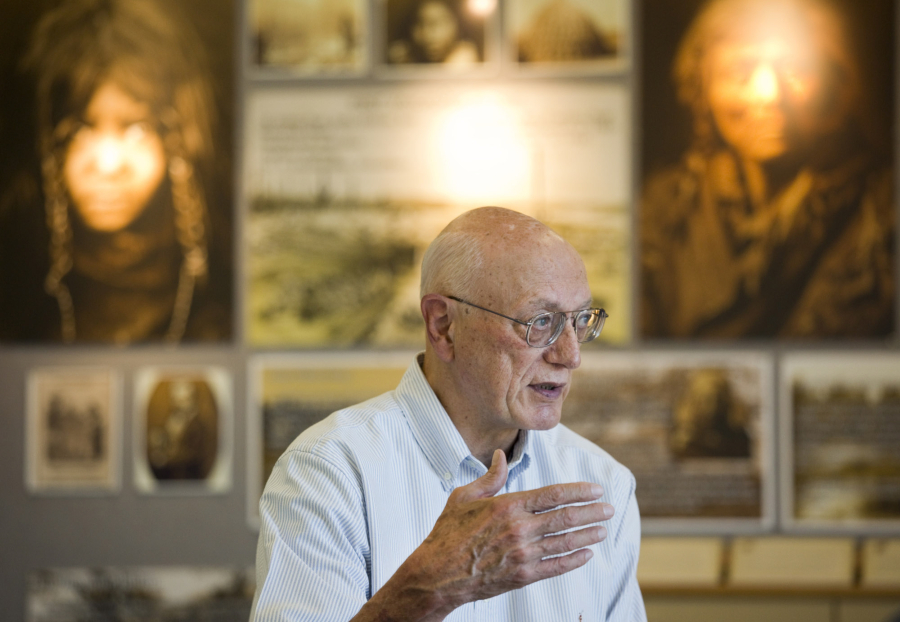BATTLE GROUND — The name of this town bugs some people. They know it’s not accurate. The battle that was expected to occur here in November 1855 fizzled out. What happened instead is the subject of more than 160 years of speculation, meditation and mystery.
This year’s seventh annual “History’s Mysteries,” an exhibit produced by the Friends of the Battle Ground Community Library and local historians Louise Tucker and Don Higgins, examines the evidence and offers a battery of possible solutions to the central riddles generated by that encounter.
Who killed Chief Umtuch? And what about that battle?
Everybody knows the simplified version of the tale that’s spelled out in a mural on the Andersen Dairy wall on Main Street. But Higgins and Tucker wanted to go deeper and explore the clash of cultures that could well have resulted in serious bloodshed — but didn’t.
“I thought there has to be more to it,” Higgins said. “Who were the Indians? Why couldn’t they leave the fort? Who chased them and why? Why were they allowed to return on their own?
“The real story is the reason why there wasn’t a battle,” Higgins said.
Explosive
The Yakima Indian War of the late 1850s was just revving up when William Strong, an Oregon Territory Supreme Court judge who had volunteered to become a captain of the Washington Volunteers and was stationed at Fort Vancouver, wrote to The Oregonian with a message of calm. The small band of Indians at the mouth of the Lewis River was nothing to fear, he wrote. They were peaceful and frightened; furthermore, they had been disarmed and moved near to Fort Vancouver where the whites could keep an eye on them.
But many of the Indians slipped away again at night. The Oregonian reported an “Indian stampede” and predicted severe punishment by Strong and his men. Strong and his own mixed company of soldiers and citizen volunteers set out in pursuit — and found the Indians in the area that’s now called Allworth, near Battle Ground Lake.
“Savage hearts beat on both sides,” Higgins writes in a handy brochure that you can take away from the exhibit. The Indians feared endless internment by the whites; the whites were reading Portland and Oregon City newspapers that fanned their hatred of Indians. So, even though there was little history of violent conflict in what was then “Clarke” County, Higgins writes, tensions were explosive. Many of the white volunteers were in a real frenzy, he said, and would go on to participate in other massacres.
Strong man
But not here. Judge Strong was in charge, and he proved to be a man of peace. “A judge would have looked at this situation very differently than a military man or volunteer,” Tucker said. “He played a very unusual role.” Strong didn’t attack or capture the Indians; the two parties parleyed and agreement was reached. Chief Umtuch would return with his band to the fort the next day.
That didn’t happen. The body of Chief Umtuch was discovered in a field. His murder has never been solved. On one wall of the History’s Mysteries exhibit, Higgins offers no fewer than 10 possible theories. We won’t spoil them here other than to say they range from mistaken identity to freak accident to rebellious conspiracy — either by Umtuch’s own band or by Strong’s key lieutenants.
Whatever the cause, their chief was dead. The Indians wanted additional time to mourn before returning to the fort. Strong agreed and withdrew his troops.
To say he was not admired for these multiple peaceful negotiations is putting it mildly. It was considered the height of folly to trust the Indians — even though they did eventually return to the fort as promised. Still, Strong was mocked by the press and even by women at the fort who presented him a red petticoat — a girly undergarment — as his emblem of courage.
“He came back without his Indians,” Higgins said. “He was stuck with that for the rest of his life.”
But Major Gen. John Wool, the subsequent commander of Fort Vancouver, believed that citizen militias “were just intent on exterminating the Indians, could rarely tell friend from foe, and did much more harm than good,” Higgins writes in the brochure. Wool disbanded the militia group under Strong’s command.
In an interview 23 years later, according to Higgins, Strong said: “In such trouble the Indians are more scared than the white men, and they would keep out of the way if you would let them.”
Labor of love
The above is a short synopsis of a longer, far more complex set of circumstances and cultural forces that are fleshed out in historical photographs, placards and maps at the library. Many of the photos are from the classic collection of Edward S. Curtis, a famed photographer of Indian life in the early 1900s. Higgins wrote the text, he said.
The whole thing cost about $1,500 — and hundreds of hours of research and writing — to assemble, Tucker said. Fortunately, the Friends of the Battle Ground Community Library make about $1,000 a month on used book sales, Higgins said.
Higgins is particularly fascinated by the story behind the battle that never happened — because his own great-great-grandmother was the sole Indian survivor of a massacre of her entire family by white volunteers, he said. And yet, she was adopted by a white family and went on to marry a white man, he said. It was a complex and confusing time, Tucker pointed out — a time of both trade and mistrust, intermarriage and murder.
“I have learned a lot” in doing the research for this exhibit, Higgins said. “It’s been a labor of love.”




